



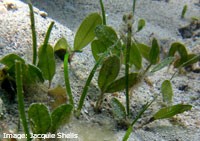
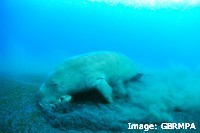
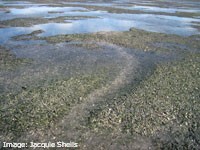

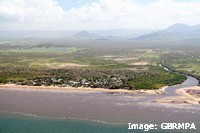
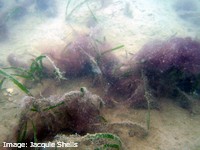
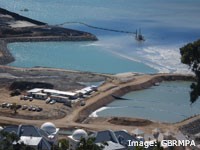

Dugongs
What on earth is a dugong?
Dugongs, or ‘sea cows’ (Dugong dugong), belong to the only vegetarian group of marine mammals, the Sirenia. The name comes from the ancient Greek sirens, who lured sailors to their deaths on the rocks with their beauty: to see the resemblance you would have to be alone at sea for a very long time!
The Sirenians
There are only four existing species: one dugong and three species of manatee. A fifth species, Steller’s sea cow, became extinct from hunting by sailors in the 1700s. Their closest relatives are elephants, but their last common ancestor was about 60 million years ago.
Home sweet home: dugong habitats
Dugongs are only found in the Indo-west Pacific, between about 26 and 27 degrees north and south of the equator, as they need water temperatures above 18 degrees Celcius to survive. They prefer wide, shallow, protected bays and mangrove creeks or channels and the sheltered coasts of inshore islands. In the northern Great Barrier Reef dugongs also feed on deep water seagrass meadows which range to 60km offshore and 37m depth.
Australia: last stronghold of the dugong
Northern Australia, between Shark Bay in Western Australia and Moreton Bay in Queensland, is the world stronghold for dugongs, with an estimated population of about 90,000. The northern Great Barrier Reef is home to an estimated 14,000 dugongs. These large dugong populations were one of the reasons for World Heritage listing of the Great Barrier Reef.
Commercial harvesting of dugong
A commercial dugong fishery in Queensland between 1847 and 1969, used their meat, oil, bones, fat, tusks and hides. In the 1850s, Dr William Hobbs, the Queensland Medical Officer, promoted dugong oil as a cure for lung diseases and rheumatism, launching a market for medicinal dugong oil. A combination of commercial hunting and entanglement in fishing nets caused dugong numbers to drop so much that they were legally protected in Queensland as long ago as 1888.
The Repulse Bay dugong fishery
There was a sporadic commercial dugong fishing operation in Repulse Bay in the Whitsundays between 1890 and 1900. William Saville-Kent wrote about this operation:
'The price, or value of goods paid by the station proprietor to the natives (sic) for each dugong captured, is five shillings; but of these the purchaser only requires the oil-producing livers, and the hides, bones and teeth, leaving the natives the carcases to feast upon. The hides, if well cured, realise a price of 4½d per lb, the large tusks of the male about half-a-crown per pair, while the bones make the best charcoal for sugar refining. [...] After many years experience it has been found at the Repulse Bay Station that the old cows yield the most oil, the quantity being sometimes as much as eight or ten gallons, but on the average only four or five. The winter months, in respect of the amount of oil obtained, are the most profitable ones for the industry.'
Dugong populations on the Great Barrier Reef today
Records of the numbers of dugongs caught in shark nets in Queensland since 1962, as well as the results of aerial surveys between 1980 and 2000, have shown a relatively stable population north of about Cooktown, but continuing declines in numbers to the south, leading to increased efforts to protect dugong on the southern Great Barrier Reef.
Indigenous people and dugong
Dugongs are sacred to Aboriginal people and are hunted to provide meat for important ceremonial occasions. Many traditional owners on the Queensland coast have voluntarily stopped hunting dugongs since dramatic population declines have occurred in the southern Great Barrier Reef.
Dugongs depend on seagrass
Dugongs rely entirely on seagrasses for food; they have been known to eat seaweed, but only when seagrass is not available. They are quite choosy about which kinds of seagrasses, preferring Halodule and Halophila species. These seagrasses are lower in fibre and higher in protein than other species of seagrass but are found in surprisingly patchy, sparse-looking ‘meadows’. Even very small patches of the right species of seagrass can be important; in Shoalwater Bay, one dugong was tracked spending several months in a tiny seagrass bed only a few metres wide.
A Dugong's life
Dugongs live mostly in small groups, although large herds are sometimes seen. They have eyesight comparable to a human wearing a snorkelling mask, and good hearing. They can communicate over short distances by making chirping sounds underwater. Dugongs don’t have the long distance sound communication or sonar used by many whales and dolphins.
Dugongs can swim at speeds up to 20kph in short bursts, but their average speed is only 10kph. They mainly feed in shallow water close to shore, making them very vulnerable to boat strikes. Most of the time dugongs don’t travel very far from home, they generally move between 15 and 40km from their favourite feeding areas, although they can make journeys of up to 600 km in search of food. Studies using satellite tracking suggest that they have good memories, as they can travel hundreds of kilometres to return to favourite feeding areas.
Vital statistics
Adult dugongs can reach between 2.4 and 3m long and weigh between 250 and 420kg, calves are born at 1.1 to 1.25m long and weigh between 27 and 35kg. They don’t have a dorsal fin, as dolphins do, but they have very ‘dolphin-like’ tails and flippers that allow them to move very gracefully in the water.
Dugongs spend most of their time in shallow water, surfacing every few minutes to breathe, closing flaps over their nostrils when they dive. They can be hard to see, as they are very shy and surface very quietly to breathe, without the characteristic ‘blow’ of whales & dolphins. The longest they can stay underwater is thought to be about 8 minutes.
Dugong dining and gardening
The skull of a dugong is structured with a broad, downward facing mouth with large, bristly lips, allowing them to ‘vacuum’ up as much as 40kg of seagrass a day, roots and all. Mature males, and some older females grow large tusks which may play a role in uprooting seagrass; growth layers in these can be used to find out how old they are.
To deal with their high fibre plant diet, they have evolved a large intestine which can be up to 30m long and as thick as a fire hose, lined with ‘friendly’ bacteria that help with digestion. To keep them underwater as they feed, they have extra dense bones which counteract their buoyancy.
As they feed they leave characteristic meandering trails, which can be seen in shallow seagrass beds at low tide. Dugong feeding has been compared to gardening: when they feed they uproot seagrass and disturb the sediment, this promotes the growth of the species of seagrass that they prefer to eat, which tend to be the first ones to grow back after disturbance.
Making more dugongs
Females start breeding between the age of 6 and 17. They usually have a single calf that takes 13-14 months to develop. The calf stays very close to its mother, suckling milk for about 18 months from teats which are in a similar position to human breasts (hello sailor?). Cows only calve every 2.5 to 5 years, depending on how much food is available.
Shallow tidal estuaries and sandbanks are used as birthing areas. As adults, dugongs have few natural predators but sharks, crocodiles and killer whales can prey on calves. Because of their slow breeding rate, dugong populations need at least a 95% survival rate to be viable. A death rate of more than 5% threatens the future of dugongs.
It’s not easy being a dugong
Dugongs are listed as vulnerable to extinction on the IUCN Redlist. Threats to the survival of dugong worldwide include:
- loss of seagrass habitat due to coastal development
- loss or degradation of seagrass habitat due to water pollution
- loss or degradation of seagrass habitat from climate change, due to increased storm damage, rising sea levels and increased temperatures
- Unsustainable hunting
- accidental boat strikes
- disturbance by frequent boat traffic
- entanglement in marine debris and fishing gear
How you can help dugongs...
- Join a local conservation group!
- Report stranded or dead dugongs: call the marine Animal Stranding Hotline at RSPCA Qld 1300 ANIMAL (1300 264625)
- Support local programs to monitor and protect dugong habitat, such as Seagrass Watch
- Avoid littering the marine environment: pick up litter when you visit the beach, even if it isn’t yours!
- Water quality begins at home (and at work...)! Remember that the chemicals you use will ultimately end up in the sea. Use environmentally friendly chemicals; avoid artificial herbicides and pesticides if you can. If you have to use harmful chemicals, follow the instructions on the label carefully and avoid uses that might let chemicals wash into drains or waterways.
- Go slow for those below!! Dugongs feed in shallow inshore waters: slow your boat speed and keep a good lookout to avoid striking them. If you can, travel in deeper water where there is less dugong activity. Change course to avoid disturbing feeding dugongs.
- disturbance by frequent boat traffic
- Check your crab pots and nets regularly: dugongs drown when they become entangled in poorly designed or unattended fishing gear
More information:
Special measures to protect dugongs
Queensland rules protecting dugongs
Dugong protection areas information
Maps of Dugong Protection areas in the Whitsunday Region:
GBRMPA Responsible Reef Practices:
Get involved, report dugong sightings:
Volunteer groups:
Downloadable resources:
GBRMPA Tropical Topics: Meadows of the Sea
GBRMPA Tropical Topics: Stories from the Blue Highway
Indian Ocean Sea Turtles: Dugongs
Dugongs in the Great Barrier Reef, Current State of Knowledge April 2002, Reef CRC
Marine Animal Stranding Hotline poster
Australian Government brochure: Harmful Marine Debris
Looking after protected species in Queensland: a guide for recreational fishers
Looking after protected species in Queensland: a guide for commercial fishers
Websites:
University of Queensland: Dugongs
Society for marine mammalogy: Dugongs
Australian Government: dugongs
Marine Parks WA: Fun Facts, Dugongs
Reports:
GBRMPA Great Barrier Reef Outlook Report: Dugongs
Exploiting Marine Wildlife in Queensland: The Commercial Dugong and Marine Turtle Fisheries


